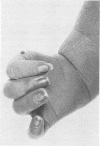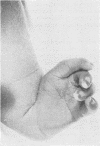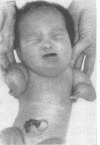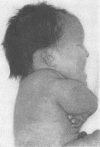Abstract
A retrospective anatomical and family study was made of 345 patients with oesophageal atresia who were born in the South West of England between 1942 and 1973. There were 186 males and 159 females. Twenty-one cases were stillborn. Eighty-five percent of the patients had a combination of oesophageal atresia with a tracheo-oesophageal fistula to the distal oesophageal segment, and 9 percent had atresia without a fistula. Fifty-five per cent of the patients had other congenital malformations and these tended to be multiple rather than single. Thirty-six per cent of singletons had unequivocal fetal growth retardation, and there is some evidence that nearly all cases have poor fetal growth. There appeared to be a maternal age effect, with an excess of mothers under 20 and over 35, and there was an unexplained excess of fathers employed in the Armed Forces. Ten per cent of the cases were illegitimate. There were 21 twins which is nearly three times the expected number; there were two pairs of twins concordant for oesophageal atresia, one being monozygotic and the other dizygotic. In one case there were two sibs with oesophageal atresia. Five out of 365 sibs had anencephaly. The blood group distributions of the patients and their mothers did not significantly differ from the expected distribution. Oesophageal atresia is aetiologically heterogenous. In this series there were at least five, and probably 10 cases of trisomy 18 and four cases of trisomy 21. Five mothers had overt diabetes, and there is some suggestion from other work that maternal diabetes or its treatment may be aetiologically important. Oesophageal atresia was part of a possibly recessively inherited malformation syndrome in two cases. A sibship with a case of rectal atresia, a case of Hirschprung's disease and a case of oesophageal atresia may represent the action of another recessive gene. It seems likely that oesophageal atresia is a rather non-specific consequence of several teratological processes.
Full text
PDF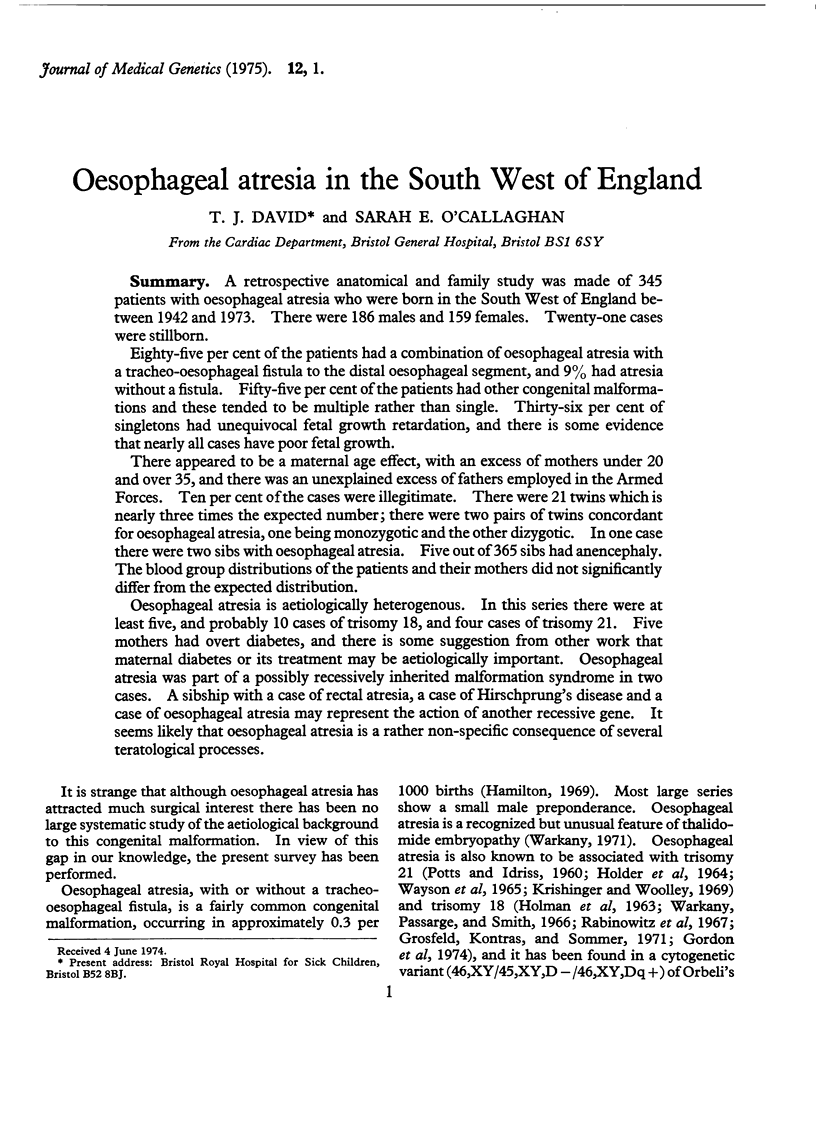
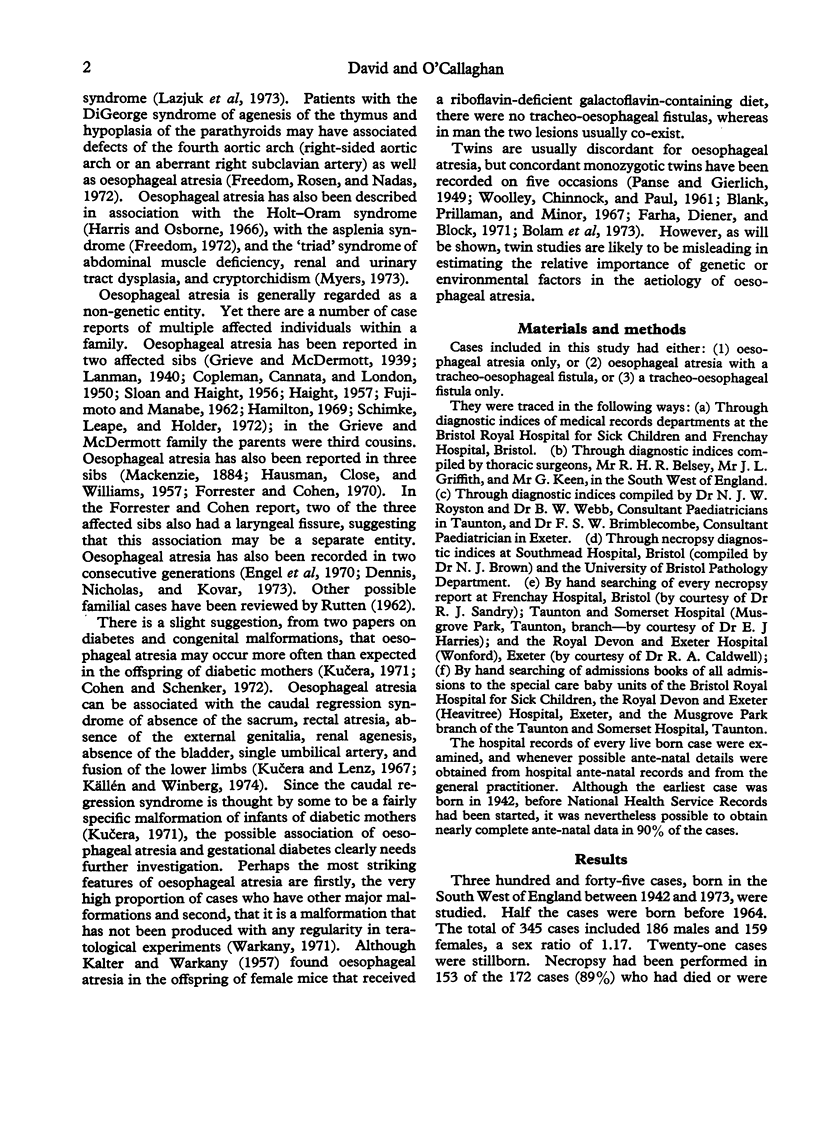
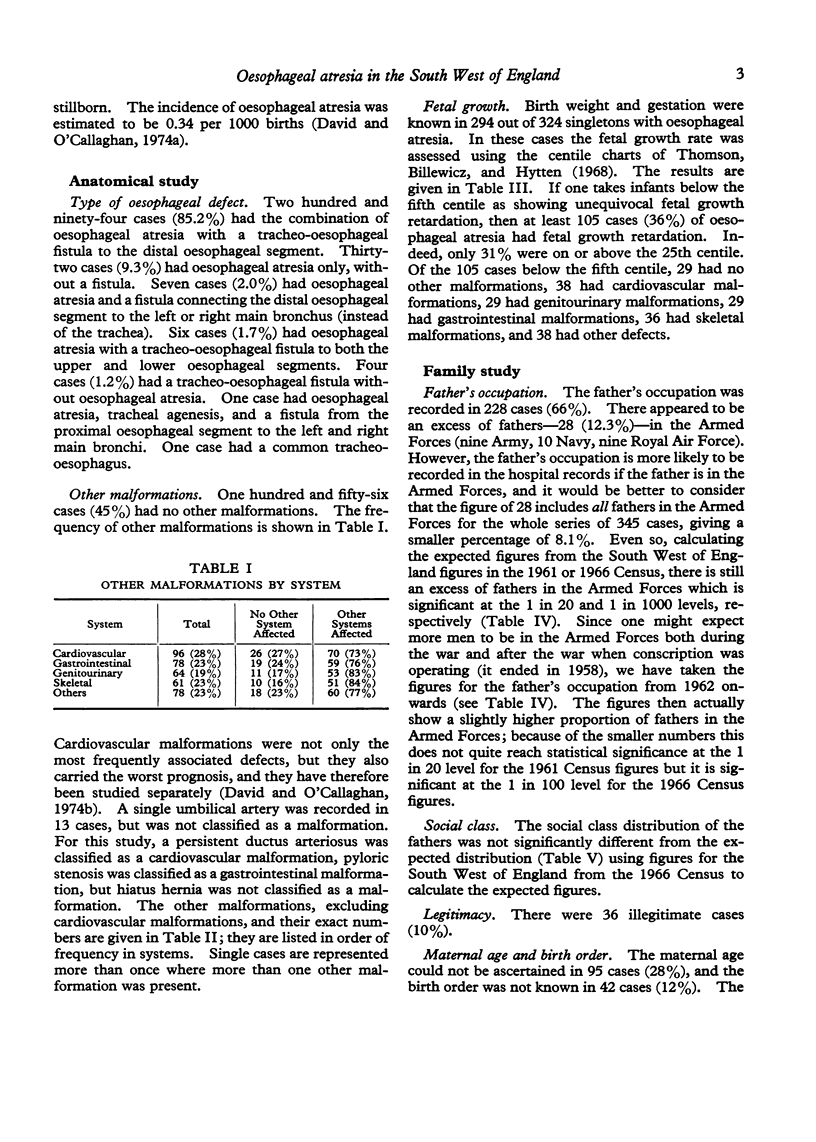
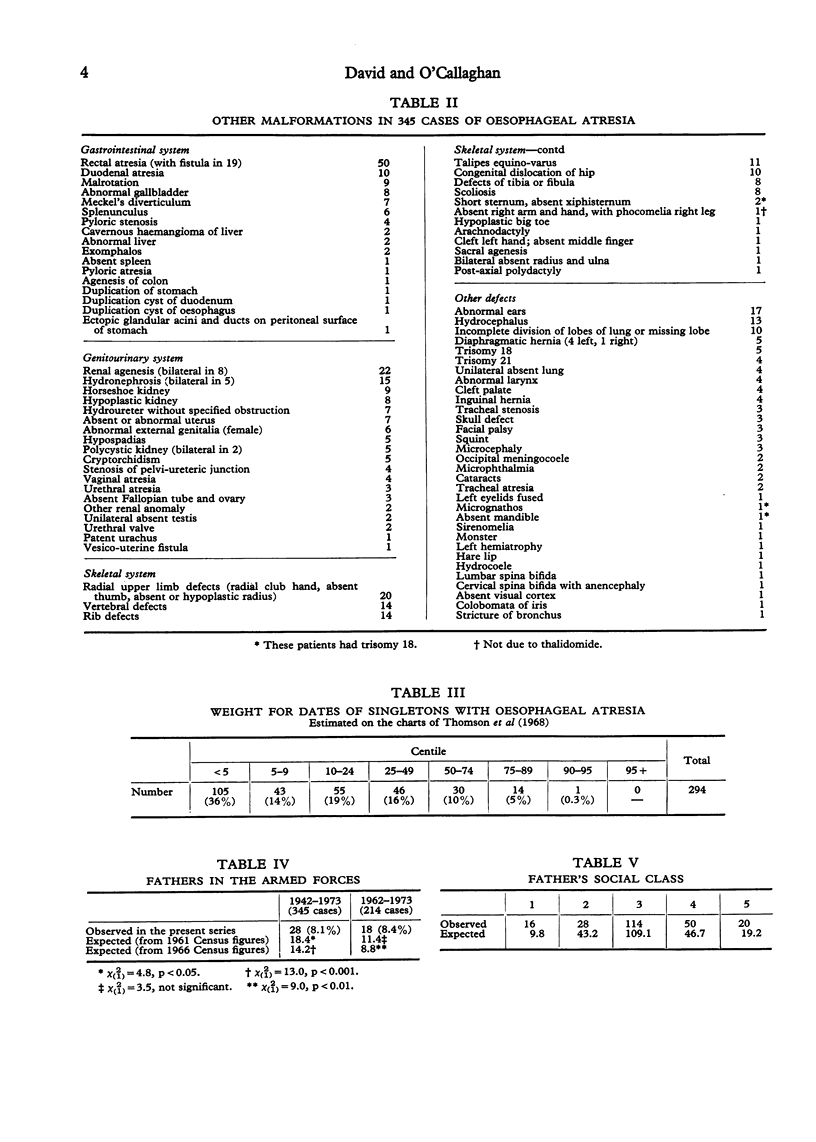
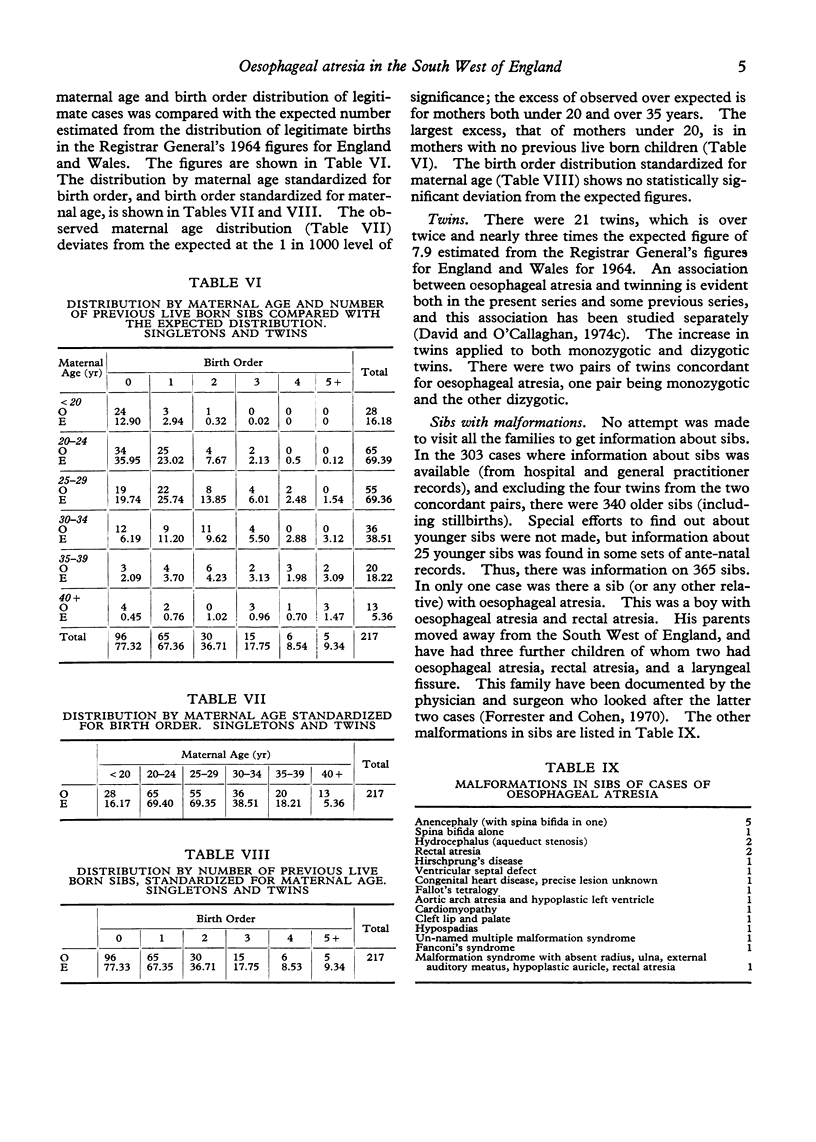
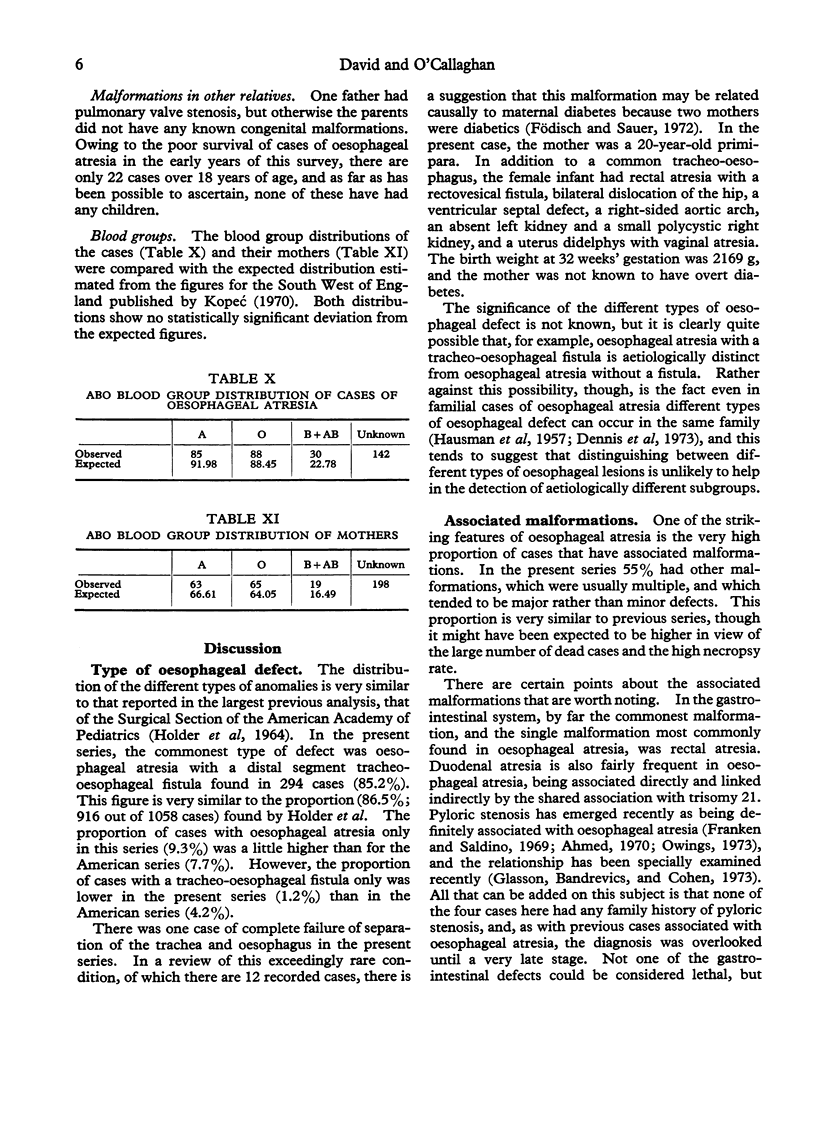
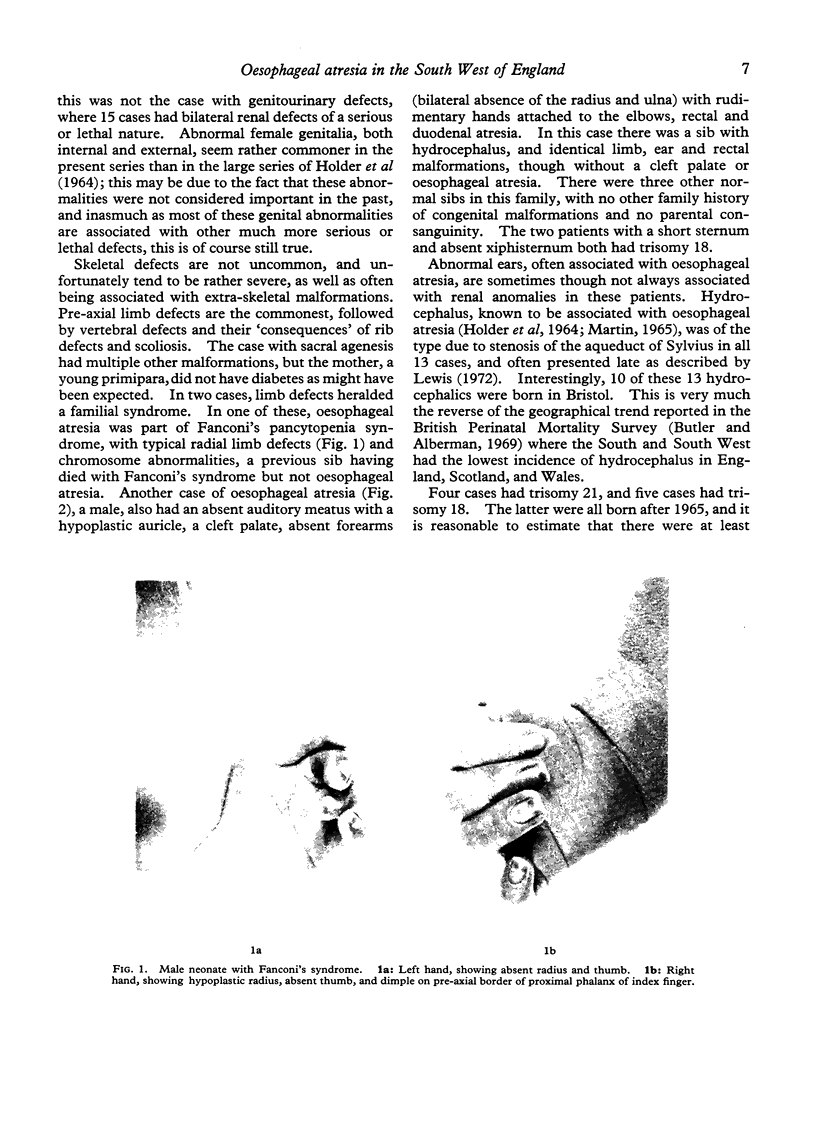
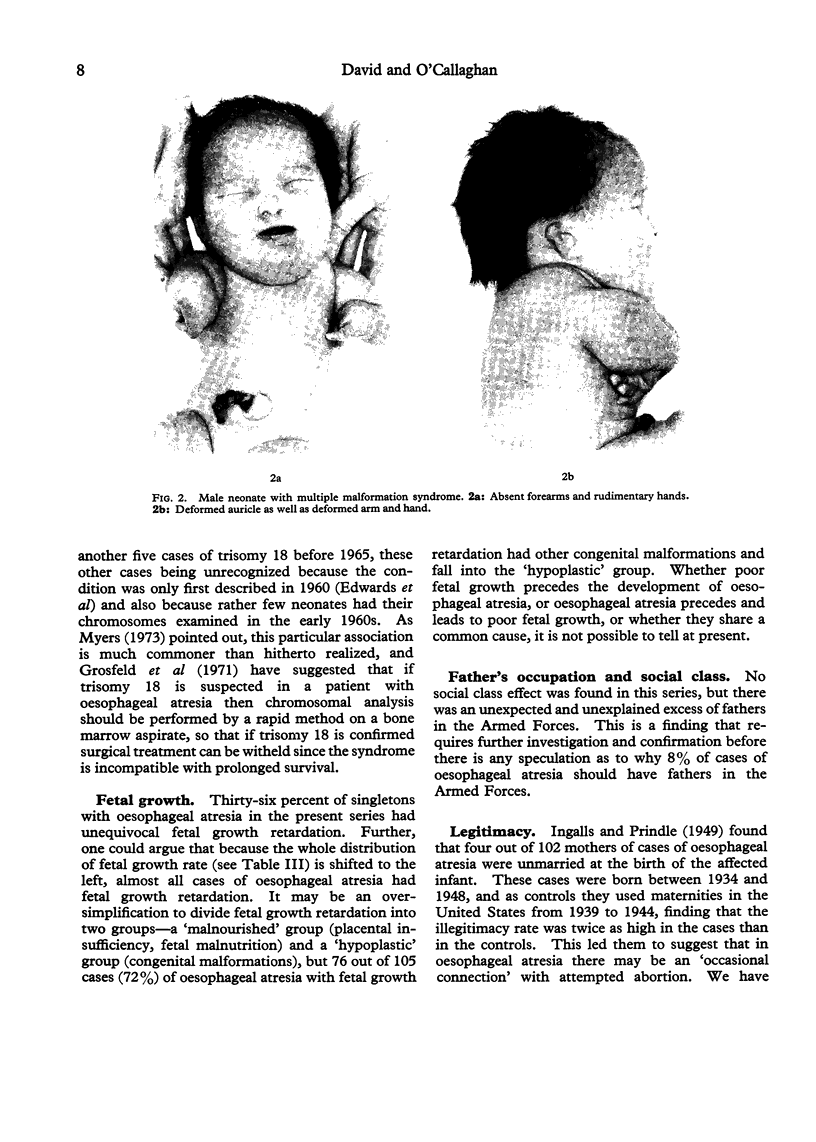
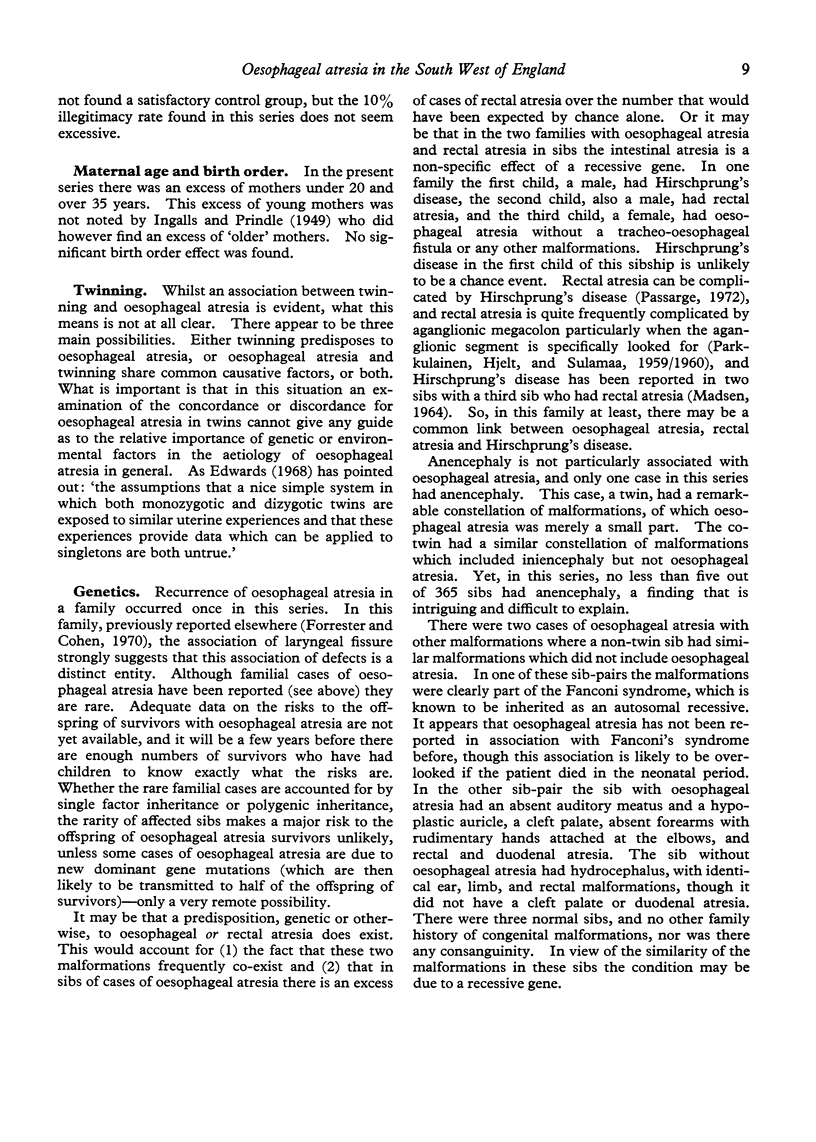
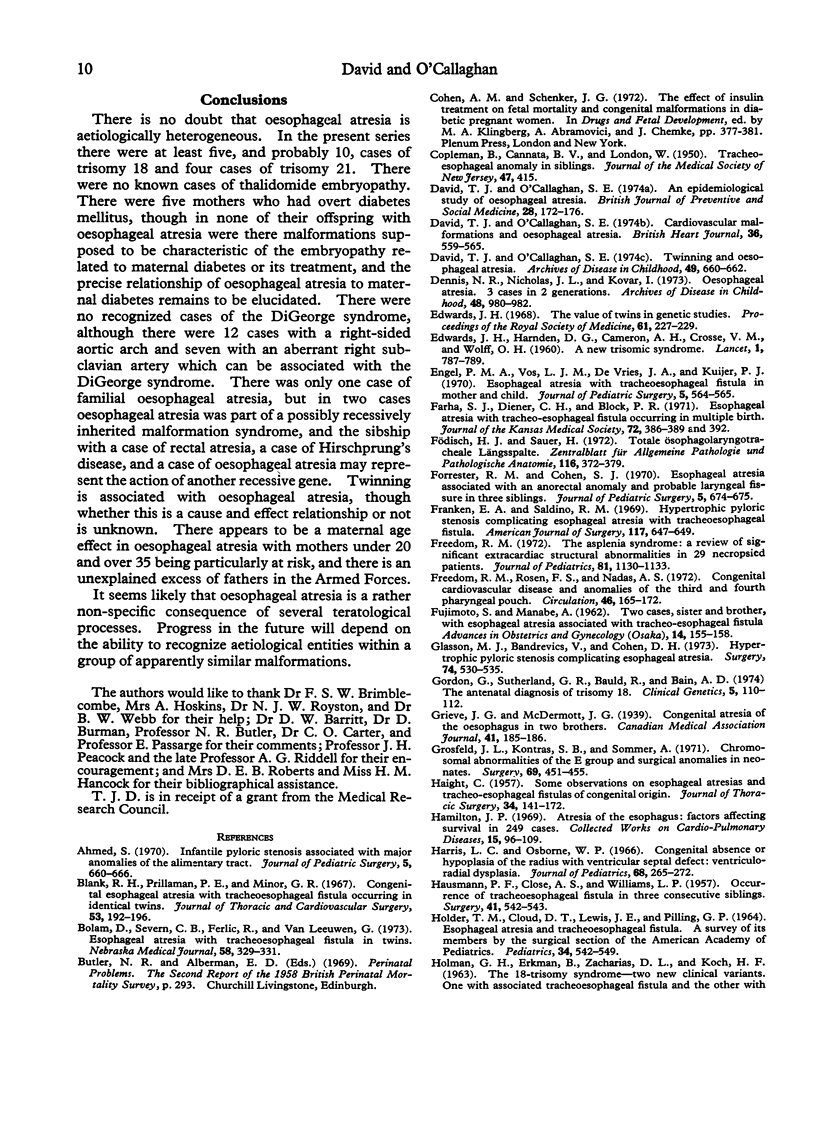

Images in this article
Selected References
These references are in PubMed. This may not be the complete list of references from this article.
- Ahmed S. Infantile pyloric stenosis associated with major anomalies of the alimentary tract. J Pediatr Surg. 1970 Dec;5(6):660–666. doi: 10.1016/s0022-3468(70)80013-6. [DOI] [PubMed] [Google Scholar]
- Blank R. H., Prillaman P. E., Jr, Minor G. R. Congenital esophageal atresia with tracheoesophageal fistula occurring in identical twins. J Thorac Cardiovasc Surg. 1967 Feb;53(2):192–196. [PubMed] [Google Scholar]
- Bolam D., Severn C. B., Ferlic R., Van Leeuwen G. Esophageal atresia with tracheoesophageal fistula in twins. Nebr Med J. 1973 Sep;58(9):329–331. [PubMed] [Google Scholar]
- COPLEMAN B., CANNATA B. V., LONDON W. Tracheo-esophageal anomaly in siblings. J Med Soc N J. 1950 Sep;47(9):415–415. [PubMed] [Google Scholar]
- Cohen A. M., Schenker J. G. The effect of insulin treatment on fetal mortality and congenital malformations in diabetic pregnant women. Adv Exp Med Biol. 1972;27:377–381. doi: 10.1007/978-1-4684-3219-0_30. [DOI] [PubMed] [Google Scholar]
- David T. J., O'Callaghan S. E. An epidemiological study of oesophageal atresia. Br J Prev Soc Med. 1974 Aug;28(3):172–176. doi: 10.1136/jech.28.3.172. [DOI] [PMC free article] [PubMed] [Google Scholar]
- David T. J., O'Callaghan S. E. Cardiovascular malformations and oesophageal atresia. Br Heart J. 1974 Jun;36(6):559–565. doi: 10.1136/hrt.36.6.559. [DOI] [PMC free article] [PubMed] [Google Scholar]
- David T. J., O'Callaghan S. E. Twinning and oesophageal atresia. Arch Dis Child. 1974 Aug;49(8):660–662. doi: 10.1136/adc.49.8.660. [DOI] [PMC free article] [PubMed] [Google Scholar]
- Dennis N. R., Nicholas J. L., Kovar I. Oesophageal atresia. 3 cases in 2 generations. Arch Dis Child. 1973 Dec;48(12):980–982. doi: 10.1136/adc.48.12.980. [DOI] [PMC free article] [PubMed] [Google Scholar]
- EDWARDS J. H., HARNDEN D. G., CAMERON A. H., CROSSE V. M., WOLFF O. H. A new trisomic syndrome. Lancet. 1960 Apr 9;1(7128):787–790. doi: 10.1016/s0140-6736(60)90675-9. [DOI] [PubMed] [Google Scholar]
- Edwards J. H. Multiple pregnancy: the value of twins in genetic studies. Proc R Soc Med. 1968 Mar;61(3):227–229. [PMC free article] [PubMed] [Google Scholar]
- Engel P. M., Vos L. J., de Vries J. A., Kuijjer P. J. Esophageal atresia with tracheoesophageal fistula in mother and child. J Pediatr Surg. 1970 Oct;5(5):564–565. doi: 10.1016/0022-3468(70)90011-4. [DOI] [PubMed] [Google Scholar]
- FUJIMOTO S., MANABE A. [Two cases, sister and brother, with esophageal atresia associated with tracheo-esophageal fistula]. Sanfujinka No Shinpo. 1962 Jul;14:155–158. [PubMed] [Google Scholar]
- Farha S. J., Diener C. H., Block P. R. Esophageal atresia with tracheo-esophageal fistula occurring in multiple birth. J Kans Med Soc. 1971 Sep;72(9):386–passim. [PubMed] [Google Scholar]
- Forrester R. M., Cohen S. J. Esophageal atresia associated with an anorectal anomaly and probably laryngeal fissure in three siblings. J Pediatr Surg. 1970 Dec;5(6):674–675. doi: 10.1016/s0022-3468(70)80015-x. [DOI] [PubMed] [Google Scholar]
- Franken E. A., Jr, Saldino R. M. Hypertrophic pyloric stenosis complicating esophageal atresia with tracheoesophageal fistula. Am J Surg. 1969 May;117(5):647–649. doi: 10.1016/0002-9610(69)90398-5. [DOI] [PubMed] [Google Scholar]
- Freedom R. M., Rosen F. S., Nadas A. S. Congenital cardiovascular disease and anomalies of the third and fourth pharyngeal pouch. Circulation. 1972 Jul;46(1):165–172. doi: 10.1161/01.cir.46.1.165. [DOI] [PubMed] [Google Scholar]
- Freedom R. M. The asplenia syndrome: a review of significant extracardiac structural abnormalities in 29 necropsied patients. J Pediatr. 1972 Dec;81(6):1130–1133. doi: 10.1016/s0022-3476(72)80244-0. [DOI] [PubMed] [Google Scholar]
- Glasson M. J., Bandrevics V., Cohen D. H. Hypertrophic pyloric stenosis complicating esophageal atresia. Surgery. 1973 Oct;74(4):530–535. [PubMed] [Google Scholar]
- Gordon G., Sutherland G. R., Bauld R., Bain A. D. The antenatal diagnosis of trisomy 18. Clin Genet. 1974;5(2):110–112. doi: 10.1111/j.1399-0004.1974.tb01670.x. [DOI] [PubMed] [Google Scholar]
- Grieve J. G., McDermott J. G. CONGENITAL ATRESIA OF THE OESOPHAGUS IN TWO BROTHERS. Can Med Assoc J. 1939 Aug;41(2):185–186. [PMC free article] [PubMed] [Google Scholar]
- Grosfeld J. L., Kontras S. B., Sommer A. Chromosomal abnormalities of the E group and surgical anomalies in neonates. Surgery. 1971 Mar;69(3):451–455. [PubMed] [Google Scholar]
- HAIGHT C. Some observations on esophageal atresias and tracheoesophageal fistulas of congenital origin. J Thorac Surg. 1957 Aug;34(2):141–172. [PubMed] [Google Scholar]
- HAUSMANN P. F., CLOSE A. S., WILLIAMS L. P. Occurrence of tracheoesophageal fistula in three consecutive siblings. Surgery. 1957 Apr;41(4):542–543. [PubMed] [Google Scholar]
- HOLDER T. M., CLOUD D. T., LEWIS J. E., Jr, PILLING G. P., 4th ESOPHAGEAL ATRESIA AND TRACHEOESOPHAGEAL FISTULA. A SURVEY OF ITS MEMBERS BY THE SURGICAL SECTION OF THE AMERICAN ACADEMY OF PEDIATRICS. Pediatrics. 1964 Oct;34:542–549. [PubMed] [Google Scholar]
- HOLMAN G. H., ERKMAN B., ZACHARIAS D. L., KOCK H. F. The 18-trisomy syndrome-two new clinical variants. One with associated tracheoesophageal fistula and the other with probable familial occurrence. N Engl J Med. 1963 May 2;268:982–988. doi: 10.1056/NEJM196305022681804. [DOI] [PubMed] [Google Scholar]
- Hamilton J. P. Atresia of the esophagus: factors affecting survival in 249 cases. Coll Works Cardiopulm Dis. 1969 Dec;15:96–109. [PubMed] [Google Scholar]
- KALTER H., WARKANY J. Congenital malformations in inbred strains of mice induced by riboflavin-deficient, galactoflavin-containing diets. J Exp Zool. 1957 Dec;136(3):531–565. doi: 10.1002/jez.1401360308. [DOI] [PubMed] [Google Scholar]
- Krishinger G. L., Woolley M. M. Esophageal atresia and tracheo-esophageal fistula. 25 years' experience and current management. Calif Med. 1969 Sep;111(3):165–168. [PMC free article] [PubMed] [Google Scholar]
- Kucera J., Lenz W. Caudale Regression mit Oesophagusatresie und Nierenagenesie--ein Syndrom. Z Kinderheilkd. 1967;98(4):326–329. [PubMed] [Google Scholar]
- Kucera J. Rate and type of congenital anomalies among offspring of diabetic women. J Reprod Med. 1971 Aug;7(2):73–82. [PubMed] [Google Scholar]
- Källén B., Winberg J. Caudal mesoderm pattern of anomalies: from renal agenesis to sirenomelia. Teratology. 1974 Feb;9(1):99–111. doi: 10.1002/tera.1420090113. [DOI] [PubMed] [Google Scholar]
- Lazjuk G. I., Lurie I. W., Kravtzova G. I., Usoev S. S. New cytogenetic variant of Orbeli's syndrome (46,XY-45,XY,-D-46,XY,Dq+). Humangenetik. 1973 Dec 10;20(3):219–221. doi: 10.1007/BF00385733. [DOI] [PubMed] [Google Scholar]
- Lewis E. Late presentation of stricture of the aqueduct of Sylvius. Aust Paediatr J. 1972 Oct;8(5):287–292. doi: 10.1111/j.1440-1754.1972.tb01839.x. [DOI] [PubMed] [Google Scholar]
- Martin L. W. Management of esophageal anomalies. Pediatrics. 1965 Sep;36(3):342–350. [PubMed] [Google Scholar]
- PARKKULAINEN K. V., HJELT L., SULAMAA M. Anal atresia combined with aganlionic megacolon. Acta Chir Scand. 1960 Jan 30;118:252–256. [PubMed] [Google Scholar]
- POTTS W. J., IDRISS F. Review of our experience with atresia of the esophagus with and without complicating fistulae. Md State Med J. 1960 Sep;9:528–537. [PubMed] [Google Scholar]
- Rabinowitz J. G., Moseley J. E., Mitty H. A., Hirschhorn K. Trisomy 18, esophageal atresia, anomalies of the radius, and congenital hypoplastic thrombocytopenia. Radiology. 1967 Sep;89(3):488–491. doi: 10.1148/89.3.488. [DOI] [PubMed] [Google Scholar]
- SLOAN H., HAIGHT C. Congenital atresia of the esophagus in brothers. J Thorac Surg. 1956 Aug;32(2):209–215. [PubMed] [Google Scholar]
- Thomson A. M., Billewicz W. Z., Hytten F. E. The assessment of fetal growth. J Obstet Gynaecol Br Commonw. 1968 Sep;75(9):903–916. doi: 10.1111/j.1471-0528.1968.tb01615.x. [DOI] [PubMed] [Google Scholar]
- WAYSON E. E., GARNJOBST W., CHANDLER J. J., PETERSON C. G. ESOPHAGEAL ATRESIA WITH TRACHEOESOPHAGEAL FISTULA; LESSONS OF A QUARTER CENTURY'S EXPERIENCE. Am J Surg. 1965 Aug;110:162–167. doi: 10.1016/0002-9610(65)90007-3. [DOI] [PubMed] [Google Scholar]
- WOOLLEY M. M., CHINNOCK R. F., PAUL R. H. Premature twins with esophageal atresia and tracheo-esophageal fistula. Acta Paediatr. 1961 Jul;50:423–430. doi: 10.1111/j.1651-2227.1961.tb08196.x. [DOI] [PubMed] [Google Scholar]
- Warkany J., Passarge E., Smith L. B. Congenital malformations in autosomal trisomy syndromes. Am J Dis Child. 1966 Dec;112(6):502–517. doi: 10.1001/archpedi.1966.02090150046002. [DOI] [PubMed] [Google Scholar]



